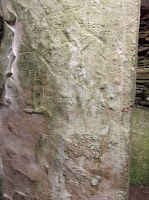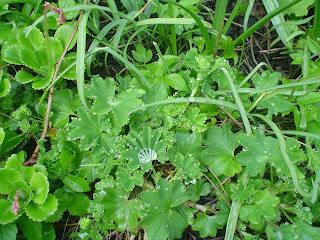Last week was mostly cold, mostly wet. The two bright spots were the greenhouse, where everything is maturing nicely, even the courgettes and pumpkins coming through when I expect them, and the goldfinches. A few months ago I moved my desk into the window so I could work in the light, and it has been the best thing I could have done.
I have watched as the hills changed from stone-grey to green to gorse yellow, and finally disappeared into a blue haze behind the leaves of the windbreak trees. I’ve watched the blossom in the orchardwax and wane like moonlight. I’ve seen my neighbour give his lovely birch trees a brutal short-back-and-sides, and I’ve watched the goldfinches hanging out, too high up to be obvious at street level, but perfectly visible to me as I sit in the dormer pretending to work. There are so many of them, which surprised me, as I thought they were only occasional visitors. They are doing very well in suburbs, apparently, because so many people put out niger seeds specifically for them.

I meant to post this picture earlier this week. It was taken on Sunday from Ossian’s Hall, at The Hermitage, near Dunkeld. We’d been up that way to visit the Loch of the Lowes, where we got a glimpse – just the top of her head showing above the nest – of the famous Lady, who is incubating three eggs at the age of twenty-five – a phenomenal age for an osprey. It’s a lovely visitor centre, and the staff are really helpful, chatty and informative. They have a blog too, which you can see here, which is well-written, and updated often.
Ossian’s Hall is a big imposing kind of folly, redeemed only by this fabulous view. But just up the track is Ossian’s cave, which is much more the thing. I’m not sure quite how my mind was working on Sunday, because I was too bowled over by this little gem to take a photograph. But it’s like a cross between a hobbit hole, curved roof, merged into the hillside so you can hardley see it, and with tiny windows out to give glorious views, and the very best kind of child’s gang hut.
I loved it, but not as much as I loved the longhouse we saw just outside Killin. This was inhabited by a family until 1968, and is being conserved (not restored) by the National Trust. It has living accommodation at one end and a byre for the cattle at the other.
This is the roof of the byre. It’s a simple, quasi-primitive structure (but I am beginning to think that what we call primitive is actually very highly-adapted and refined to the needs of the place, and we don’t recognise it because we like things complex and versatile, and reflecting our fantasies).It reminded me of the farmhouse at Stong in Iceland which they’ve dug out of the tephra from a volcanic eruption in 1763, and of old farmhouses in Ireland, so often replaced by sprawling ranch-type villas in the Celtic Tiger years. I got a sense of the continuity of earth-wisdom which so many people have evolved over years of living and loving the place they live in. I can feel a poem coming on.
It was as we parked here that we heard a cuckoo. It’s been years since I heard one of them.
And since Sunday, this week has been full of rain, but there was a swift flying over the garden as I filled the kettle for breakfast. I hope it has brought some higher temperatures with it.


































